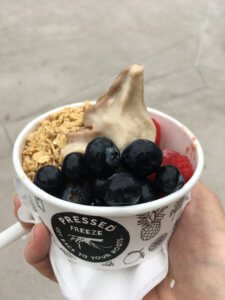
Not a smoothie bowl, but “frozen smoothie soft serve” – an entirely different thing.
Feedback on last week’s California smoothie bowl post ranged from “having a “bowl” for breakfast sounds fun!”, to one person making a mental note to actually try a “bowl”, to a comment/question combo about a certain popular chain food establishment that offers an acai bowl loaded with sugar and calories and did I know whether the acai base at “Paradise Bowls” is pure acai.
The comment portion begged further investigation – just how loaded is “loaded?” – the question portion was enlightening. “Pure” acai base? I’d honestly not even considered it. The exchange spawned this week’s topic; the “health halo” phenomenon.
As evidenced in a 2008 New York Times article by John Tierney, “Health Halo Can Hide the Calories,” the concept of the “health halo effect” isn’t new, but as this may be your first encounter with the idea, I’ll explain.
The “health halo effect” is a term bestowed on (or attached to) particular foods or food brands, conferring a sense that the food or brand in question is a HEALTHY or HEALTHIER choice. A “health halo” is a concept based on pure perception (and sometimes, deception.) If you perceive a certain food or brand to be “healthier”, you may believe it has less calories, won’t clog your arteries, or stops breast cancer cells in their tracks; all of which, based on the actual nutrition science behind the food or brand, may or may not be true (especially the stopping breast cancer cells idea.)
Thanks to clever marketing, non-credentialed social media “wanna be” nutrition experts (aka food bloggers), and all sorts of kooky food lore picked up say, via your hair stylist or nail salon tech, certain foods (and food “terms”) unwaveringly glow under the infamous “health halo.”
A few examples:
- Muffins
- Granola bars
- Energy bars
- “Protein-boosted or enhanced” anything
- Granola
- Protein powder
- Smoothies (and by association, “bowls”)
- 100-calorie packs
- “Low-fat”
- Organic
- Juicing
- “Natural”

Not on the “health halo” list, but a non-alcoholic pina colada contains fruit, so it’s all “good”, right?
Which brings me back to the reader comment/question about “bowls.”
Online acai bowl nutrition info from the popular chain noted total calories (490 – not outrageous, depending on. . .keep reading) and sugar (67 grams – no break-down of “added” vs. natural, but makes sense with the volume of fruit!), but didn’t address the question about a “pure” base. A quick call to a nearby location revealed that no sugar, nor any other ingredients, is added to the acai packets, which, by the way come pre-packaged from headquarters. Pure acai base? Check.
Next, I dialed up “Paradise Bowls”. Calorie/nutrition labeling (online or otherwise) isn’t required for restaurants or food establishments with less than 20 locations – they have four. Once again I was assured of the purity of the acai base – no added sugar or other ingredients.
Ok, so does a pure acai base a “healthy” acai bowl make? Not necessarily. First we’d need to define “healthy”; I’ll save that for a future post. For now, consider this.
Although a “bowl” is made predominantly of fruit, with the occasional addition of yogurt and often “plant-based milk”, “healthy”, as well as calorie count, is dependent on the particulars of your order.
A serving of fruit = 60 calories; 100% nutritious and healthy calories, but they still count. While plain almond milk is ridiculously low in calories, the added sugar in vanilla or chocolate bumps them up. Add a range of toppings like granola (popular chain adds ~ 5 ounces!), coconut, cacao nibs, honey, hemp seeds, and even more fruit, and the calories begin to inch well into three digits. Not that three digits is a “bad” thing, mind you – ha, I can read your mind!

Hotel room “dinner”; hummus. Hmmm. Could have a halo.
Please know this, I’m addressing calories not because a food’s calorie count determines healthfulness, but rather as a reminder that “health halo” can be a green light to consume huge quantities of a food without regard for calories. Remember “Snackwell Syndrome?” Consistently eating extra calories over and above what you need translates to weight gain; overweight and obesity are known risk factors for breast cancer diagnosis and recurrence. My goal in sharing information is all about reducing both of those, so here’s a trick.
Order the size (do they offer kid-size? mini?) that fits your appetite and activity level that day. After a 3-hour hike? There’s more wiggle room for a larger size. Having a “bowl” as a meal vs. a between-meal snack? Same. Mindful of carbs due to diabetes or insulin-resistance? Go with a small size, limit the volume and number of toppings, and increase the protein.
